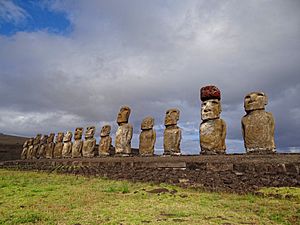Ahu Tongariki facts for kids
Ahu Tongariki (pronounced ah-oo tong-gah-ree-kee) is the biggest stone platform, called an ahu, on Easter Island, also known as Rapa Nui. This special place once had many giant stone statues, called moai. Sadly, these statues were knocked over during local conflicts on the island. Later, in the 1900s, a huge ocean wave called a tsunami pushed the ahu even further inland.
But don't worry! Ahu Tongariki has been carefully put back together. Now, it proudly displays fifteen moai. One of these statues is super heavy, weighing about eighty-six tonnes! That's the heaviest statue ever stood up on the island. Ahu Tongariki is located near Rano Raraku and Poike in the Hotu-iti area of Rapa Nui National Park. A cool fact is that all the moai here face the sunset during the winter solstice.
History of Ahu Tongariki
Ahu Tongariki was once a very important place for the Hotu-iti clan. This group of people lived on the eastern side of Rapa Nui. The area was like their main center or capital.
Over time, there were conflicts among the islanders. During these fights, the giant moai statues at Ahu Tongariki were pushed over. Then, in 1960, a powerful tsunami hit the island. This giant wave was caused by an earthquake far away in Chile. The tsunami swept the already fallen ahu and its statues even further inland.
Luckily, Ahu Tongariki was brought back to life in the 1990s. A team of experts, including archaeologists Claudio Cristino and Patricia Vargas Casanova, worked hard for five years. They had help from the Chilean government, the University of Chile, and a Japanese company called Tadano Limited. Together, they carefully restored this amazing historical site.
Where is Ahu Tongariki?
This important ahu is found on the southern coast of Rapa Nui. It's close to two extinct volcanoes: Poike and Rano Raraku.
Poike is one of the three main volcanoes that helped form Rapa Nui. Rano Raraku is a volcanic crater. It's made from hardened volcanic ash, which is called tuff. This tuff was the perfect material for carving the giant moai statues. Almost half of all the hundreds of moai ever made are still found in the main quarry on the slopes of Rano Raraku. The flat land below Rano Raraku made it easy for the ancient islanders to get to the tuff they needed.
Images for kids
-
Map of Rapa Nui showing major ahus with moai. Rano Raraku and Ahu Tongariki are on the southern coast near Poike at the eastern end of the island.
See also
 In Spanish: Ahu Tongariki para niños
In Spanish: Ahu Tongariki para niños






